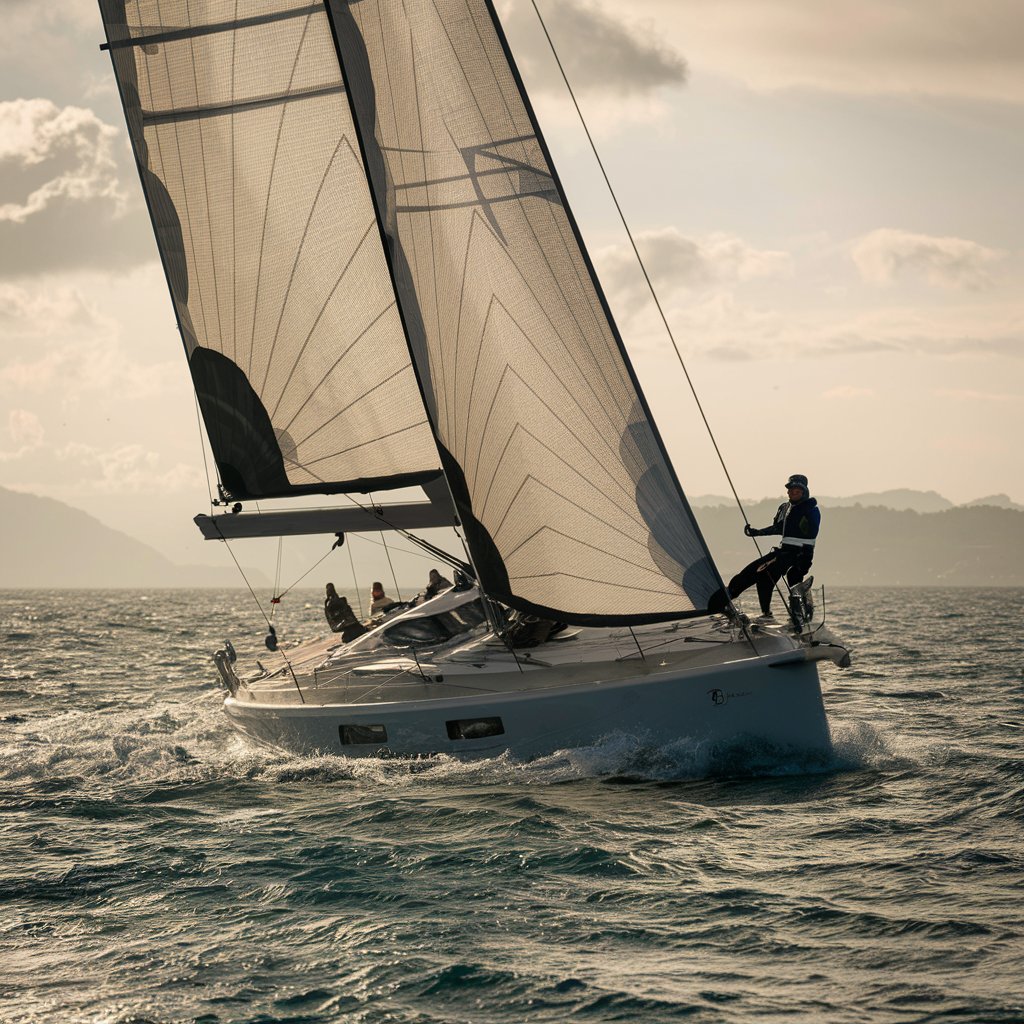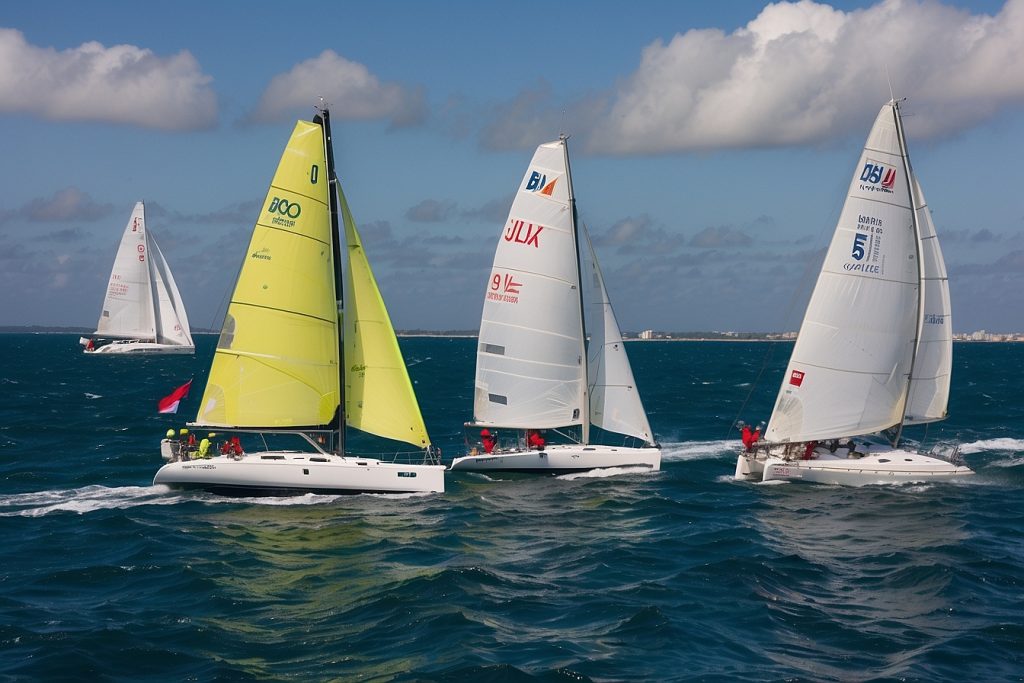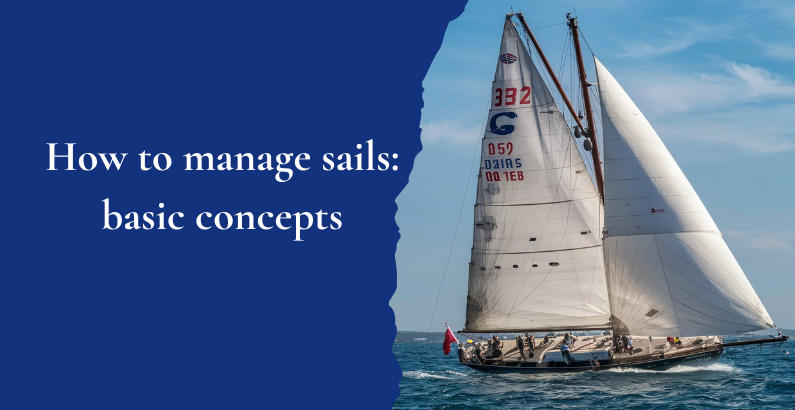A sailboat is propelled by the force of the wind, so the sailor’s task is to learn how to control the sails correctly to take advantage of this force. To do this, it is necessary to understand how to set the sails, what are the courses relative to the wind and how to make turns.
Why a sailboat does not capsize
Surprisingly, a modern sailboat is capable of moving at any angle to the wind. The exception is “dead center,” about 45 degrees to the wind. The helmsman often places the boat in position on purpose when it is important that the wind does not interfere with the unfurling or retracting of the sails.
Another important point for those who fear that a sailboat may capsize under unfortunate circumstances. For some people, a sailboat turning upside down does not inspire any confidence and causes panic. Take it easy. Remember that a heavy bulb is attached to the bottom of the sailboat. This structure weighs several tons, which is often half the weight of the entire sailboat.
Thanks to this bulb, which acts as a counterweight, the sailboat does not capsize even in the event of heavy rolling. In exceptional cases, in a very strong storm or a jolt, the boat may capsize, but it will then return to its original position, with the mast up. This principle is reminiscent of a child’s toy. And this is the advantage of a monohull sailboat over motor yachts and canoes.

Nautical terms
It is very important, especially in racing, that the helmsman and sailors understand each other and speak the same language. Let us remind you of the basic terms that are used when working with sails.
A boat’s diametral plane (DP) is an invisible line that divides the boat in half from bow to stern. The wind direction is determined relative to it.
The tack is the distance the boat travels in a straight line, without turning. If the wind blows to the port side, it is called a port tack, and if it blows to the starboard side, it is called a starboard tack.
Leeward (board, side) – facing closer to the wind. Leeward – the one farther from the wind.
“To go up ” – to go where the wind is blowing from. “To go down” – to go in the direction of the leeward side.
Luffing – a zigzag movement of the boat on a right or left tack, with turns being made.
Rigging – all the tackle and armament of a yacht. “Standing rigging is that which is set once and is stationary. Running rigging includes those tackles that are set in motion when necessary, including for setting sails.
A furler is one of the edges of a sail.
Tell-tale – thin ribbons on the sail to help determine wind flow and direction.
Belly – the bulge of the sail, which can be different in size (depth) and position.
Twist – the depth and position of the “belly” of the sail.
Topenant – tackle of running rigging, which helps to keep the rails, boom and other parts in the right position.
Top – the top of the mast.
Drive – to point the bow of a yacht toward the wind.
Pitch – to move the bow of the boat away from the wind.
Picking – pulling the rope toward you, thereby pulling it taut.
To weave – to release the rope, thereby releasing the tension.
Fluting – reducing the sail area.
Main sails on a yacht
There are two main sails on a standard sailing yacht: mainsail and jib. These are the ones that are used first to set the yacht in motion. The mainsail is the sail that is attached to the mast and to the boom, the horizontal bar needed to tension this sail and to set it at a certain angle.
The mainsail comes in two types: classic and furling. The classic mainsail is kept in a special case attached to the boom, which protects the sail from the sun and water. It is also called a lazy jack. When hoisted, the sail is hoisted up by the mainsail halyard. The mainsail usually has battens. These are special flat long plates, similar to rulers, which can be inserted horizontally or vertically evenly across the sail. This allows the shape of the mainsail to be better held, and so you can sail with confidence even in light winds. There are variants of classic mainsails, which are spread over the boom on one side and then covered with a cover. Such a mainsail is more difficult to clean, especially if the sail area is large. Several sailors may be required for such a task.
Charter and private yachts often use a simplified system – a furling mainsail. With a special mechanism, the mainsail is easily untwisted and furled into the mast along the boom. Experienced yachtsmen consider such a device less reliable and far from real sailing. With such a system, finer tuning of the mainsail is not available and it is less aerodynamic.
The staysail is another triangular sail that is forward and occupies the area between the mast and the battens. It is quite simple to manage. The staysail is furled on a rope that connects the bow of the boat to the top of the mast at an angle. It is called a staysail. This sail can be carried on the port or starboard side, depending on the wind direction.
Another type of foresail is the genoa or genoa jib. It is more imposing in area than the regular one, so it goes behind the mast. Depending on how much percent of the sail goes behind the mast, they say “genoa 120%”, “genoa 160%”.
What other sails there are
In addition to the mainsail and jib, there are additional sails: the gennaker and spinnaker. You can usually see these big, colorful sails at regattas. They are made of thin, lightweight material like that used for parachuting, so they are more vulnerable but more sensitive to the wind. A gennaker or spinnaker is used in light winds. These sails look very impressive due to their impressive area and more varied colors. Cleaning and setting additional sails requires some experience from both helmsman and crew.
The spinnaker is suitable for racing yachtsmen who are ready for the stresses and challenges. The mechanism for setting the spinnaker includes not only additional ropes, but also a heavy spinnaker geek. It requires at least two physically strong sailors to rig it. The spinnaker also differs from the gennaker in its symmetrical shape and larger area.
When chartering a yacht, the gennaker is usually not included in the price, but on some boats it can be ordered at an additional cost.
How to sail a yacht
The most important thing for a novice yachtsman is to understand where the wind is blowing from and depending on it to change the position of the yacht and adjust the sails. The wind direction can be determined by a weather vane on the top of the mast. For convenience, thin ribbons are also attached to the cables. More experienced yachtsmen carefully watch any changes around both on land and at sea. A ripple on the water, a slight breeze, clouds, bird behavior – all this becomes a source of information.
The main thing to remember is that a sailing yacht cannot sail directly upwind. There is a “dead” zone, where, literally, it is better not to put the boat’s nose. It’s called leventicle. To define this zone is simple. From the imaginary line of wind you need to put off the angles of 45 degrees, this sector will be the area where the yacht will simply lose the course. It is easy to determine the approach to the “dangerous” zone, as they begin to flutter chaotically, the speed drops. At such moments the helmsman should smoothly duck or on the contrary bring the yacht to the wind.
In order to sail strictly against the wind, there is maneuvering. In this case the sailing yacht moves in zigzags: from right to left tack.
How to change the motion and stop the boat
It is not enough to set the sails on a yacht once to sail it successfully. Wind direction and weather conditions change, so you have to change course and make turns. For this you need to manage the sails and the boat correctly. At the races it is interesting to observe the perfect work of professional crews, when any maneuver is made clearly, without fuss and unnecessary words. This is what happens when every crew member knows what to do.

Controlling the sails on a yacht with a tiller
Small sport boats often have a tiller instead of a helm. It is believed to give better control of the boat, as the helmsman’s hand is better able to feel every movement.
Usually the tiller has an extension, which allows you to steer the boat from a distance. The main thing is to have enough space around to maneuver with the extension. During turns, the extension needs to be moved from one side to the other, which requires additional time and effort. Many athletes practice this action even on the shore. For this purpose it is enough to have three seats in the role of sides and stern, a fixed tiller with an extension and a rope representing a boom-shkot.
Usually sports yachts with tiller may not have a keel. For this purpose there is a centerboard, a retractable fin necessary for ballast to keep the yacht from being carried downwind.
Advice for efficient sail handling
Setting sails is a whole art, where you have to take into account not only where the wind is blowing from, but also with what strength. Each situation requires a specific action, and this comes with sea practice, for example:
- In light winds up to 10 knots it is better to open the sails as much as possible to make them look “poofy”.
- If the wind blows up to 17 knots, it is necessary to adjust the sail profiles, to make them “tighter”. In case of a strong roll it is worth reefing the mainsail.
- It is important to reef the sails in time if the wind is expected to increase. It will be much easier to do this in advance, before the squall arrives.
- Do not allow the sails to “flap” in the wind, because of this they become unusable faster, and such thin sails as gennaker or spinnaker can even tear.
- Keep an eye on the tell-tales. They should flutter in the flow of the wind. If they don’t, the sails are not working efficiently enough.
- It is better to work on the winches with gloves. Never try to hold the lines with your bare hands, without the winch, and do not put your fingers on the winch when putting the lines on the winch.
- The more the boat is lurching, the less the wind helps her to develop speed, so you need to compensate for this force with the help of sailors on one or the other side.
The art of sail handling can be learned almost all your life by getting into different situations. Participation in training practices and regattas allows you to learn and learn more from more experienced sailors.




